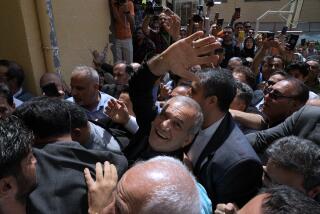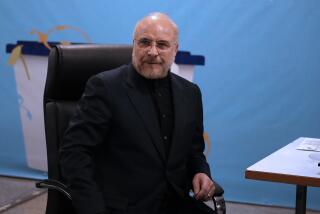Local Iranians do their part in protest
As authorities in Tehran have blocked opposition websites, jammed satellite TV channels and banned foreign journalists from covering demonstrations against last week’s disputed elections, Iranians living in the U.S. have rushed to fill the communications gap.
Iranian students and exiles here are flooding Facebook, Twitter, YouTube and their e-mail distribution lists with footage of bloodied protesters and other snippets gleaned from friends and relatives back home. And they are serving as conduits for information among supporters of Iran’s presidential challenger, Mir-Hossein Mousavi, who cannot reach each other through text messaging.
An Iranian engineering student at USC described how her friends in Iran were struggling to confirm if and when a massive march to Tehran’s Freedom Square would take place Monday. They couldn’t access websites sympathetic to Mousavi, but the students here could. So she relayed the details of the march to everyone she knew through e-mail -- and if that didn’t work, called their land lines.
“We don’t want to just sit down and watch everything that is happening in Iran,” said the 23-year-old, who did not want her name published for safety reasons. “Whatever we find out, we tell them.”
On Wednesday night, hundreds of expatriates in the L.A. area, home to one of the largest Iranian American communities in the U.S., gathered at major intersections in Westwood and Irvine to protest the violent crackdown on protesters challenging President Mahmoud Ahmadinejad’s reelection as fraud. In San Diego, about 200 people demonstrated downtown.
Saadat, 23, who immigrated as a child, brought a camera to Irvine to collect video to post on her Facebook page to show protesters at home that they have support. In the last few days, she said, she has posted articles she has gathered on the unfolding events, at the request of friends and family in Iran. She described these efforts as an attempt to create a new “grass-roots media.”
Wednesday’s demonstrations were the latest in a string of local protests, which have brought together a cross-section of the expat community, not all of whom seemed comfortable sharing a platform. There were young students wearing opposition green, many of them with their faces covered and holding up posters demanding: “Where is my vote?” And there were aging supporters of Iran’s deposed shah, flying the pre-Islamic Revolution Iranian flag, who had not wanted their fellow demonstrators to vote in an election they regard as a sham.
“I think they are both here for the wrong reasons,” said Holly, a fashionably dressed 22-year-old cradling a Chihuahua at a boisterous demonstration Tuesday outside the Federal Building in Westwood. Although Iranians had more social freedoms before the Islamic Revolution toppled Shah Mohammed Reza Pahlavi 30 years ago, she argued that the monarchy was as politically repressive as the current rulers.
“If they really want change,” she said, “they have to start doing the same thing they did in 1979. Yes, there will be blood. But it has to happen.”
Iranians and supporters of all political and religious stripes said they have been glued to their computers in recent days, sifting through and relaying posts that update every few minutes.
Philip Grant, an American doctoral student at UC Irvine studying Iranian women’s rights, has been sending information to his friends in Iran about websites they can use to message each other and ways to circumvent the firewalls blocking access to opposition and other sites.
“We have much better access to Internet and things here, so we’re doing what we can to disseminate information,” said Grant, 32. “Right now I’m setting up a Facebook account for a person in Iran I’ve never met.”
Many of those relaying information to and from Iran described themselves as political novices, spurred on by government attempts to prevent journalists from covering protests against the election results.
“If they can’t do it, we will,” said the U.S. college-going daughter of Iranian emigres, who did not want her name published. “We just want to hear as much as we can, so we can flood the world with news.”
In the lightning-fast and frequently anonymous world of Twitter and YouTube, the line between rumor and fact is easily blurred.
Amateur video and photos broadcast across the Internet provided some of the first evidence that at least a dozen people had been killed in clashes between demonstrators and pro-government militiamen. But it was impossible to confirm posts that some of the militiamen could not speak Persian, which convinced many opposition supporters here that Iran’s rulers had brought in Arabic-speaking members of the Lebanese Hezbollah militia to crush street protests.
Adding to the confusion were reports that Iranian authorities were putting out misinformation on the Internet. Facebook and Twitter users warned each other repeatedly Wednesday to avoid sharing personal information in public forums and to ignore instructions from people with no record of reliable posts.
Secretary of State Hillary Rodham Clinton on Wednesday defended U.S. efforts to ensure Twitter remained available to Iranian protesters, even as Tehran complained about U.S. interference in its affairs. Clinton said she considered it important to keep “that line of communication open and enabling people to share information, particularly at a time when there [were] not many other sources of information.”
State Department officials earlier this week urged Twitter to delay scheduled maintenance work to avoid interrupting service. On Wednesday, Iran’s Foreign Ministry summoned the Swiss ambassador, who represents U.S. interests in the country in the absence of formal American-Iranian ties, to protest unspecified “interventionist” U.S. statements.
Previously, when anti-government demonstrations broke out in Tehran, Iran pointed the finger at a string of Southland-based Persian-language TV stations, which had tried to fan the flames using satellite technology to broadcast into the country. This time, broadcasters said they were taking a back seat.
This is partly because the Iranian government is jamming some of their stations. Internet technology is also allowing young people to bypass the traditional media. Many of them are resentful that these stations tended to urge Iranians not to vote in elections, which they believe is how Ahmadinejad came to power in the first place.
“The motto now is to just try to support the people in Iran,” said Hossein Hedjazi, who hosts a political commentary show on the 24-hour PARS TV station. “The people know much better than we do, thousands of miles away.”
--
raja.abdulrahim@latimes.com
Staff writers Paloma Esquivel in Los Angeles, Tony Perry in San Diego and Paul Richter in Washington contributed to this report.
More to Read
Sign up for Essential California
The most important California stories and recommendations in your inbox every morning.
You may occasionally receive promotional content from the Los Angeles Times.











